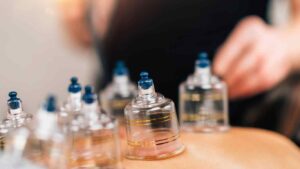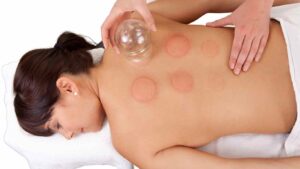Myofascial Cupping
By Remedial Massage Therapist Paige Single
Some of you may have seen the 23-time Olympic gold medallist Michael Phelps with red/purple spots all over him at this year’s Rio Olympic Games. What are they you might ask? Perhaps he fell asleep wearing his medals?
They are the result of ‘Myofascial Cupping’, used in many different ways to release myofascial tone. There has also been some controversy surrounding Phelps’ use of cupping for body maintenance, so I thought I would provides some explanations.
What is Myofascial cupping?
 ‘Myofascial Cupping’ or ‘Cupping’ an ancient Chinese therapy in which a glass, plastic or bamboo cup is applied to the skin then the pressure in the cup is reduced (either by heat or suction) in order to draw and hold skin and superficial muscle tissue/fascia inside the cup. Sometimes, while the suction is active, the cup is moved, causing the skin and muscle to be pulled. This is called ‘gliding cupping’. Cupping is applied to certain acupuncture points as well as to parts of the body that have been affected by pain or muscle/fascia tightness where the pain is deeper than the tissues to be pulled. The cupping process draws blood from your vessels and into your tissue. Your body thinks it’s been injured, so the theory is that it ‘jumpstarts’ a postive inflammatory response, mobilizing antibodies to the area to try to heal it.
‘Myofascial Cupping’ or ‘Cupping’ an ancient Chinese therapy in which a glass, plastic or bamboo cup is applied to the skin then the pressure in the cup is reduced (either by heat or suction) in order to draw and hold skin and superficial muscle tissue/fascia inside the cup. Sometimes, while the suction is active, the cup is moved, causing the skin and muscle to be pulled. This is called ‘gliding cupping’. Cupping is applied to certain acupuncture points as well as to parts of the body that have been affected by pain or muscle/fascia tightness where the pain is deeper than the tissues to be pulled. The cupping process draws blood from your vessels and into your tissue. Your body thinks it’s been injured, so the theory is that it ‘jumpstarts’ a postive inflammatory response, mobilizing antibodies to the area to try to heal it.
The Cups are fitted with a valve that attaches to a small hand-operated pump, allowing the practitioner to suck out air without having to rely on fire to depressurise the cup first. It also gives them greater control over the amount of suction.
The process
 In order to allow the cups to move over the skin easily, oil is used then cups are places on the skin in areas of tender/tight muscles, trigger points, acupressure points and then either moved along muscles to ‘release’ or ‘strip’ fascia or left in one place avoiding any broken skin. Cups are generally left in place for ten minutes although the time can range from five to fifteen minutes. The skin will normally redden due to the congestion of blood flow. The cup is removed from the skin; some circular bruising on the skin of the cup is to be expected and may stay visible for up to 2-8 days. This is a normal part of the therapy and it isn’t painful.
In order to allow the cups to move over the skin easily, oil is used then cups are places on the skin in areas of tender/tight muscles, trigger points, acupressure points and then either moved along muscles to ‘release’ or ‘strip’ fascia or left in one place avoiding any broken skin. Cups are generally left in place for ten minutes although the time can range from five to fifteen minutes. The skin will normally redden due to the congestion of blood flow. The cup is removed from the skin; some circular bruising on the skin of the cup is to be expected and may stay visible for up to 2-8 days. This is a normal part of the therapy and it isn’t painful.
In some cases where cupping is used after acupuncture the cup can draw blood from the skin. This form of cupping is to be performed in very sterile environments due to an infection risk, so post cupping treatment strict precautions need to be followed.
Athletes
Cupping for athletes can aid in the recovery process as increased blood flow from cupping may help accelerate the repair of the damaged muscle fibres that result from hard training.
Other Benefits of cupping include:
· Stimulate Blood Flow
· Drain Lymph and cellular debris
· Separate layers of connective tissue to bring hydration and blood flow to body tissues
· Soften tight muscles
· Relieve deep muscular issues and reduce muscle spasms
· Lift and stretch soft tissue to separate fascial restrictions
· Increase range of movement and flexibility in joints.
· Move stagnations of lactic acid and metabolic waste and enable normal lymphatic flow to promote healthy circulation and help strengthen the immune system.
Other specific Conditions cupping can help
· Scar tissue post-surgical
· Plantar fascia or plantar foot pain
· Stiffness or tightness in any muscular area’s
· Back Pain
· Headaches
· Neck Pain
· Chronic Pain
· Jaw Pain (TMJ)
All the Therapists at Gold Coast Physio & Sports Health (Physio’s and Massage) are able to assess and decide if Cupping is an appropriate treatment technique for you.
If you have used Cupping techniques before and like the results, let your Therapist know and they can include it in your treatment regime. Phone us for an appointment 07 5500 6470 or book online at www.mygcphysio.com.au

































